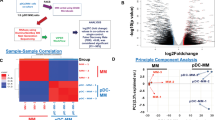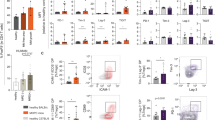Abstract
Multiple myeloma (MM) is an incurable B-cell malignancy characterized by accumulation of malignant plasma cells in bone marrow (BM) and recurrent or persistent infections. Toll-like receptors (TLRs) are essential in the host defense against infections and today 10 human TLRs (TLR1-TLR10) and one TLR-homolog (RP105) have been characterized. B cells express several TLRs (mainly TLR1, 6, 7, 9, 10 and RP105) and TLR-initiated responses in B cells include proliferation, anti-apoptosis effect and plasma cell (PC) differentiation. The present study was designed to analyze the role of TLRs in MM. We show that frequent expressions of TLRs were detected in cell lines from MM patients (minimum six TLRs in each). In comparison, only few TLRs (mainly TLR1 and or RP105) were found expressed in PCs from BM of healthy donors. In addition, TLR-specific ligands induce increased proliferation and survival of the MM cell lines, partially due to an autocrine interleukin-6 production. Importantly, we demonstrate that also PC from MM patients proliferates in response to TLR-specific ligands. In conclusion, TLR-ligands may contribute to increased growth and survival of MM cells in MM patients.
This is a preview of subscription content, access via your institution
Access options
Subscribe to this journal
Receive 12 print issues and online access
$259.00 per year
only $21.58 per issue
Buy this article
- Purchase on Springer Link
- Instant access to full article PDF
Prices may be subject to local taxes which are calculated during checkout



Similar content being viewed by others
References
O'Connor BP, Gleeson MW, Noelle RJ, Erickson LD . The rise and fall of long-lived humoral immunity: terminal differentiation of plasma cells in health and disease. Immunol Rev 2003; 194: 61–76.
Shapiro-Shelef M, Calame K . Plasma cell differentiation and multiple myeloma. Curr Opin Immunol 2004; 16: 226–234.
Hideshima T, Richardson P, Anderson KC . Novel therapeutic approaches for multiple myeloma. Immunol Rev 2003; 194: 164–176.
Seidl S, Kaufmann H, Drach J . New insights into the pathophysiology of multiple myeloma. Lancet Oncol 2003; 4: 557–564.
Anderson KC, Shaughnessy Jr JD, Barlogie B, Harousseau JL, Roodman GD . Multiple myeloma. Hematology (Am Soc Hematol Educ Program) 2002, 214–240.
Brenne AT, Baade RT, Waage A, Sundan A, Borset M, Hjorth-Hansen H . Interleukin-21 is a growth and survival factor for human myeloma cells. Blood 2002; 99: 3756–3762.
Lauta VM . A review of the cytokine network in multiple myeloma: diagnostic, prognostic, and therapeutic implications. Cancer 2003; 97: 2440–2452.
Jacobson DR, Zolla-Pazner S . Immunosuppression and infection in multiple myeloma. Semin Oncol 1986; 13: 282–290.
Oken MM, Pomeroy C, Weisdorf D, Bennett JM . Prophylactic antibiotics for the prevention of early infection in multiple myeloma. Am J Med 1996; 100: 624–628.
Akira S, Hemmi H . Recognition of pathogen-associated molecular patterns by TLR family. Immunol Lett 2003; 85: 85–95.
Akira S . Mammalian Toll-like receptors. Curr Opin Immunol 2003; 15: 238.
Bernasconi NL, Traggiai E, Lanzavecchia A . Maintenance of serological memory by polyclonal activation of human memory B cells. Science 2002; 298: 2199–2202.
Bernasconi NL, Onai N, Lanzavecchia A . A role for Toll-like receptors in acquired immunity: upregulation of TLR9 by BCR triggering in naive B cells and constitutive expression in memory B cells. Blood 2003; 101: 4500–4504.
Hornung V, Rothenfusser S, Britsch S, Krug A, Jahrsdorfer B, Giese T et al. Quantitative expression of Toll-like receptor 1-10 mRNA in cellular subsets of human peripheral blood mononuclear cells and sensitivity to CpG oligodeoxynucleotides. J Immunol 2002; 168: 4531–4537.
Jung J, Yi AK, Zhang X, Choe J, Li L, Choi YS . Distinct response of human B cell subpopulations in recognition of an innate immune signal, CpG DNA. J Immunol 2002; 169: 2368–2373.
Krieg AM . CpG motifs in bacterial DNA and their immune effects. Annu Rev Immunol 2002; 20: 709–760.
Bourke E, Bosisio D, Golay J, Polentarutti N, Mantovani A . The Toll-like receptor repertoire of human B lymphocytes: inducible and selective expression of TLR9 and TLR10 in normal and transformed cells. Blood 2003; 102: 956–963.
Bishop GA, Ramirez LM, Baccam M, Busch LK, Pederson LK, Tomai MA . The immune response modifier resiquimod mimics CD40-induced B cell activation. Cellular Immunol 2001; 208: 9–17.
Jurk M, Heil F, Vollmer J, Schetter C, Krieg AM, Wagner H et al. Human TLR7 or TLR8 independently confer responsiveness to the antiviral compound R-848. Nat Immunol 2002; 3: 499.
Peng SL . Signaling in B cells via Toll-like receptors. Curr Opin Immunol 2005; 17: 230–236.
Borset M, Waage A, Brekke OL, Helseth E . TNF and IL-6 are potent growth factors for OH-2, a novel human myeloma cell line. Eur J Haematol 1994; 53: 31–37.
Jarrossay D, Napolitani G, Colonna M, Sallusto F, Lanzavecchia A . Specialization and complementarity in microbial molecule recognition by human myeloid and plasmacytoid dendritic cells. Eur J Immunol 2001; 11: 3388–3393.
Scheel B, Teufel R, Probst J, Carralot JP, Geginat J, Radsak M et al. Toll-like receptor-dependent activation of several human blood cell types by protamine-condensed mRNA. Eur J Immunol 2005; 35: 1557–1566.
Rasmussen T, Theilgaard-Monch K, Hudlebusch HR, Lodahl M, Johnsen HE, Dahl IMS . Occurrence of dysregulated oncogenes in primary plasma cells representing consecutive stages of myeloma pathogenesis: indications for different disease entities. Br J Haematol 2003; 123: 253–262.
Rasmussen T, Jensen L, Honore L, Andersen H, Johnsen HE . Circulating clonal cells in multiple myeloma do not express CD34 mRNA, as measured by single-cell and real-time RT-PCR assays. Br J Haematol 1999; 107: 818–824.
Durie BG, Salmon SE . A clinical staging system for multiple myeloma. Correlation of measured myeloma cell mass with presenting clinical features, response to treatment, and survival. Cancer 1975; 36: 842–854.
Greipp PR, San MJ, Durie BG, Crowley JJ, Barlogie B, Blade J et al. International staging system for multiple myeloma. J Clin Oncol 2005; 23: 3412–3420.
Alexopoulou L, Holt AC, Medzhitov R, Flavell RA . Recognition of double-stranded RNA and activation of NF-kappaB by Toll-like receptor 3. Nature 2001; 413: 732–738.
Hirschfeld M, Ma Y, Weis JH, Vogel SN, Weis JJ . Cutting edge: repurification of lipopolysaccharide eliminates signaling through both human and murine Toll-like receptor 2. J Immunol 2000; 165: 618–622.
Hayashi F, Smith KD, Ozinsky A, Hawn TR, Yi EC, Goodlett DR et al. The innate immune response to bacterial flagellin is mediated by Toll-like receptor 5. Nature 2001; 410: 1099–1103.
Mita Y, Dobashi K, Endou K, Kawata T, Shimizu Y, Nakazawa T et al. Toll-like receptor 4 surface expression on human monocytes and B cells is modulated by IL-2 and IL-4. Immunol Lett 2002; 81: 71–75.
Zarember KA, Godowski PJ . Tissue expression of human Toll-like receptors and differential regulation of Toll-like receptor mRNAs in leukocytes in response to microbes, their products, and cytokines. J Immunol 2002; 168: 554–561.
Chen W, Wang J, An H, Zhou J, Zhang L, Cao X . Heat shock up-regulates TLR9 expression in human B cells through activation of ERK and NF-kappaB signal pathways. Immunol Lett 2005; 98: 153–159.
Gado K, Domjan C, Hegyesi H, Falus A . Role of interleukin-6 in the pathogenesis of multiple myeloma. Cell Biol Int 2000; 24: 195–209.
Borset M, Helseth E, Naume B, Waage A . Lack of IL-1 secretion from human myeloma cells highly purified by immunomagnetic separation. Br J Haematol 1993; 85: 446–451.
Wagner M, Poeck H, Jahrsdoerfer B, Rothenfusser S, Prell D, Bohle B et al. IL-12p70-dependent Th1 induction by human B cells requires combined activation with CD40L and CpG DNA. J Immunol 2004; 172: 954–963.
Divanovic S, Trompette A, Atabani SF, Madan R, Golenbock DT, Visintin A et al. Negative regulation of Toll-like receptor 4 signaling by the Toll-like receptor homolog RP105. Nat Immunol 2005; 6: 571–578.
Ogata H, Su I, Miyake K, Nagai Y, Akashi S, Mecklenbrauker I et al. The Toll-like receptor protein RP105 regulates lipopolysaccharide signaling in B cells. J Exp Med 2000; 192: 23–29.
Jahrsdorfer B, Muhlenhoff L, Blackwell SE, Wagner M, Poeck H, Hartmann E et al. B-cell lymphomas differ in their responsiveness to CpG oligodeoxynucleotides. Clin Cancer Res 2005; 11: 1490–1499.
Jahrsdorfer B, Wooldridge JE, Blackwell SE, Taylor CM, Griffith TS, Link BK et al. Immunostimulatory oligodeoxynucleotides induce apoptosis of B cell chronic lymphocytic leukemia cells. J Leukoc Biol 2005; 77: 378–387.
Zhong S, Yeo W, Tang M, Liu CL, Lin XR, Ho WM et al. Frequent detection of the replicative form of TT virus DNA in peripheral blood mononuclear cells and bone marrow cells in cancer patients. J Med Virol 2002; 66: 428–434.
Beg AA . Endogenous ligands of Toll-like receptors: implications for regulating inflammatory and immune responses. Trends Immunol 2002; 23: 509–512.
Kariko K, Ni HP, Capodici J, Lamphier M, Weissman D . mRNA is an endogenous ligand for Toll-like receptor 3. J Biol Chem 2004; 279: 12542–12550.
Tsan MF, Gao B . Endogenous ligands of Toll-like receptors. J Leukoc Biol 2004; 76: 514–519.
Rifkin IR, Leadbetter EA, Busconi L, Viglianti G, Marshak-Rothstein A . Toll-like receptors, endogenous ligands, and systemic autoimmune disease. Immunol Rev 2005; 204: 27–42.
Acknowledgements
We thank Marianne Lodahl at Herlev Hospital, University of Copenhagen, Denmark for technical assistance and Dr med. Anders Waage at St Olavs Hospital, Trondheim University Hospital, Norway for providing some of the patient material. This work was supported by grants from the Central Norway Regional Health Authority, Norwegian University of Science and Technology, the Norwegian Cancer Society and the Norwegian Research Council.
Author information
Authors and Affiliations
Corresponding author
Additional information
Supplementary Information accompanies the paper on the Leukemia website (http://www.nature.com/leu)
Rights and permissions
About this article
Cite this article
Bohnhorst, J., Rasmussen, T., Moen, S. et al. Toll-like receptors mediate proliferation and survival of multiple myeloma cells. Leukemia 20, 1138–1144 (2006). https://doi.org/10.1038/sj.leu.2404225
Received:
Revised:
Accepted:
Published:
Issue Date:
DOI: https://doi.org/10.1038/sj.leu.2404225
Keywords
This article is cited by
-
Prognostic significance of bone marrow and spleen 18F-FDG uptake in patients with colorectal cancer
Scientific Reports (2021)
-
Toll-Like Receptor 4 Activation Promotes Multiple Myeloma Cell Growth and Survival Via Suppression of The Endoplasmic Reticulum Stress Factor Chop
Scientific Reports (2019)
-
Targeting Toll-Like Receptors for Cancer Therapy
Targeted Oncology (2018)
-
Heterogeneity of Toll-like receptor 9 signaling in B cell malignancies and its potential therapeutic application
Journal of Translational Medicine (2017)
-
Extracellular HSP70-peptide complexes promote the proliferation of hepatocellular carcinoma cells via TLR2/4/JNK1/2MAPK pathway
Tumor Biology (2016)



